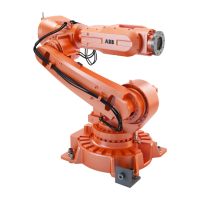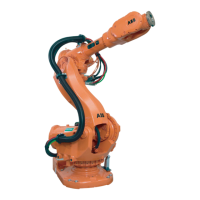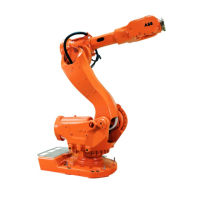[531] Advanced Motion
Product Specification RobotWare Options for BaseWare OS 4.0 13
Independent movements
A linear or rotating axis can be run independently of the other axes in the robot system.
The independent movement can be programmed as an absolute or relative position.
A continuous movement with a specific speed can also be programmed.
Examples of applications:
- A robot is working with two different stations (external axes). First, a work
object located at station 1 is welded. When this operation is completed, station
1 is moved to a position where it is easy to change the work object and at the
same time the robot welds the work object at station 2. Station 1 is moved
independently of the robot’s movement, which simplifies programming and
reduces the cycle time.
- The work object is located on an external axis that rotates continuously at a
constant speed. In the mean time, the robot sprays plasma, for example, on the
work object. When this is finished the work area is reset for the external axis in
order to shorten the cycle time.
Friction Compensation
During low speed (10-100 mm/s) cutting of fine profiles, in particular small circles, a
friction effect, typically in the form of approximately 0.5 mm “bumps”, can be noted.
Advanced Motion offers a possibility of compensating for these frictional effects.
Typically a 0.5 mm “bump” can be reduced to about 0.1 mm. This, however, requires
careful tuning of the friction level (see User’s Guide for tuning procedure). Note that
even with careful tuning, there is no guarantee that “perfect” paths can always be
generated.
For the IRB 6400 family of robots, no significant effects can be expected by applying
Friction Compensation.
RAPID instructions and functions included in this option
IndReset Resetting the work area for an axis
IndAMove Running an axis independently to an absolute position
IndDMove Running an axis independently for a specified distance
IndRMove Running an axis independently to a position within one
revolution, without taking into consideration the number of turns
the axis had rotated earlier
IndCMove Running an axis continuously in independent mode
IndInpos Checking whether or not an independent axis has reached the
programmed position
IndSpeed Checking whether or not an independent axis has reached the
programmed speed
CorrCon Activating path correction
CorrWrite Changing path correction
CorrRead Read current path correction
CorrDiscon Deactivating path correction
CorrClear Removes all correction generators

